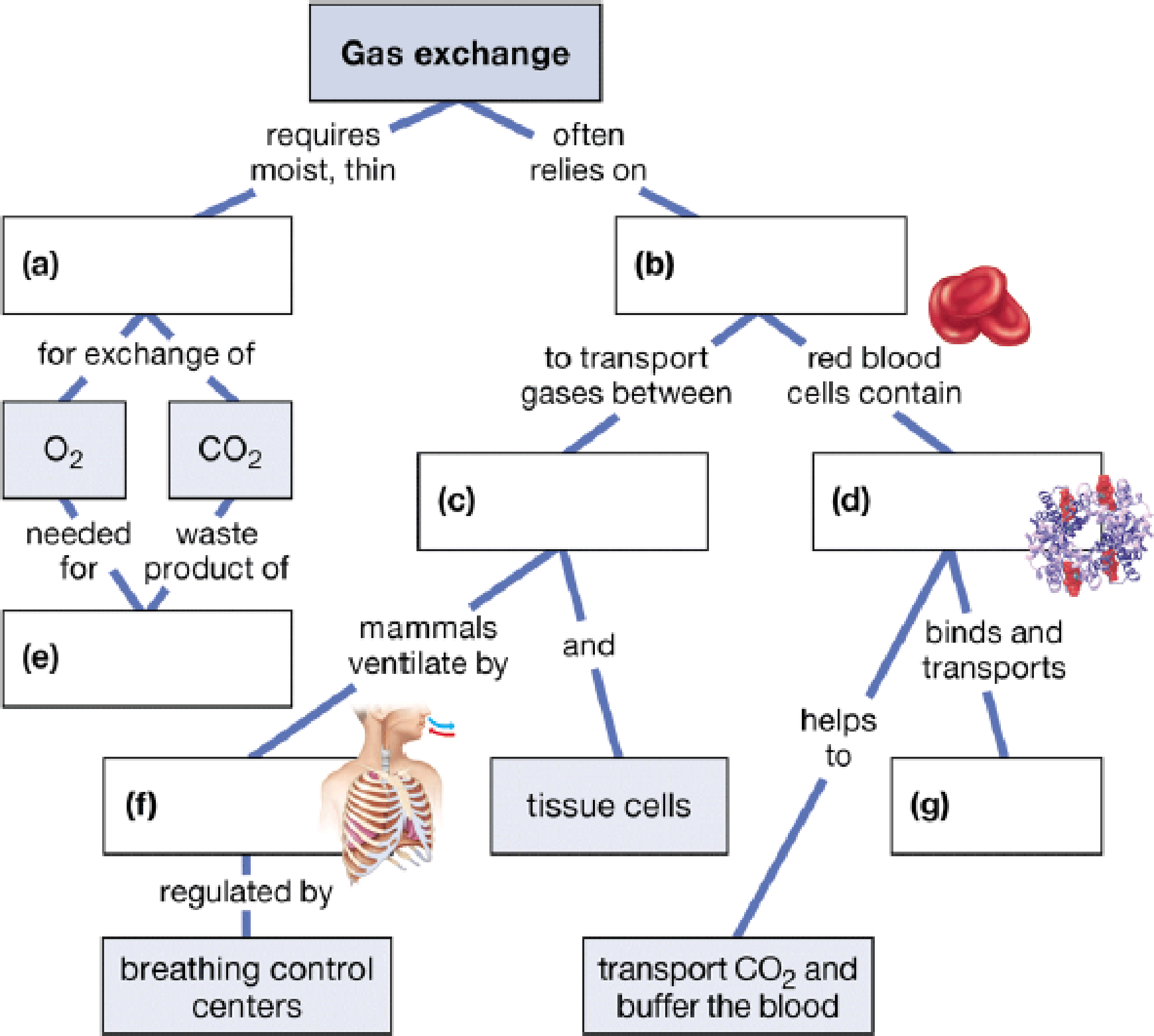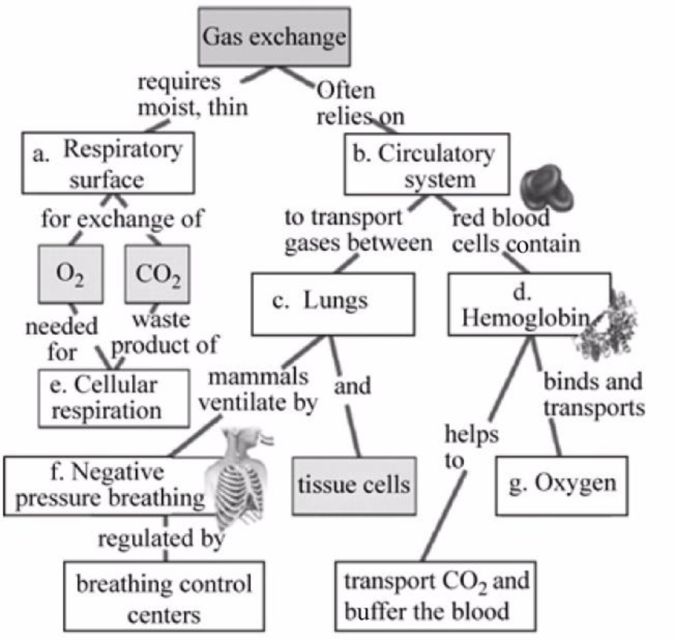
Concept explainers
Complete the following concept map to review some of the concepts of gas exchange.

To complete: The given map to review some of the concepts of gas exchange.
Introduction:
The respiratory system is a biological system that ensures the transport of air by the process of inhalation and exhalation, that is, in and out the body with the help of the lungs.
Answer to Problem 1CC
Fig.1 shows the completed map to review some of the concepts of gas exchange.
Pictorial representation: Some of the concepts related to gas exchange are presented in the concept map given in Fig.1.

Fig.1: Concepts of gas exchange.
Explanation of Solution
a.
Correct answer: Respiratory surface.
For gas exchange to occur, the respiratory surface should be thin and moist. Hence, the correct answer is the respiratory surface.
b.
Correct answer: Circulatory system.
Gas exchange relies on the circulatory system as the exchanged oxygen and carbon dioxide travel in the blood to the heart and different body cells. Hence, the correct answer is the circulatory system.
c.
Correct answer: Lungs
It is the main organ for the exchange of gases consisting of air sacs that carry out gaseous exchange and the blood carries the exchanged gas to the tissue cells. Hence, the correct answer is the lungs.
d.
Correct answer: Hemoglobin.
Hemoglobin is a blood pigment present inside the red blood cell, which helps in the transport of oxygen and carbon dioxide by binding with it and also maintains the pH of the blood. Hence, the correct answer is hemoglobin.
e.
Correct answer: Cellular respiration.
In cellular respiration, oxygen is used to convert glucose into carbon dioxide, water, and energy in the form of ATP. Hence, the correct answer is cellular respiration.
f.
Correct answer: Negative pressure breathing.
This type of breathing is regulated by the “breathing control center of the brain”. In negative pressure breathing, the air pressure inside the lungs drops during the contraction of the diaphragm, and the lower portion of the chest cavity rises; this allows the movement of air from outside to inside. Hence, the correct answer is negative pressure breathing.
g.
Correct answer: Oxygen.
Hemoglobin pigment in the blood binds with the oxygen present in the lungs, and this oxygen is utilized to form energy. Hence, the correct answer is oxygen.
Want to see more full solutions like this?
Chapter 22 Solutions
CAMPBEL BIOLOGY:CONCEPTS & CONNECTIONS
- Write the reversible equation that shows the reaction of hemoglobin (Hb) with: A. Oxygen B. Carbon dioxidearrow_forwardCreate a (hand drawn) flow diagram showing how gases enter, travel, and exit the body of the following vertebrates: fish, frogs, turtles, birds, humans. Use keywords and arrows only.arrow_forwardGas moves from an area of ________ partial pressure to an area of ________ partial pressure. low; high low; low high; high high; lowarrow_forward
- Determine the concentrations (in mole fraction) of all species in the exhaust from the incomplete combustion (90% combustion) of butane (C4H10). Assume 50% excess air with respect to complete combustion is the source for the oxygen. Air composition is 79 mol% N2 and 21 mol% O2.arrow_forwarddiscuss the mechanism of the bohr effect that occurs during the interactions of Hb with oxygen under physiological conditions in the lungs and tissues. make use of relavant graphs and diagrams to explain your answer.arrow_forwardFind the density of nitrogen (N2) and oxygen (O2) at STP assuming they behave like an ideal gas.arrow_forward
- Identify 3 physical conditions that can optimize rate of diffusion of a gas across a membrane, and relate these to Fick’s Law of Diffusion.arrow_forwardList the 4 different types of gas exchange systems. Then, describe eacharrow_forwardRefer to chemical equation shown here to explain why carbon dioxide dissolved in water acts as a buffer. H2O+CO2<>H2CO3<>H++HCO3arrow_forward
- Create an infographic about positive and negative feedback mechanism of regulation of gas concentrationarrow_forwardOne of the many mutant opponents that the movie monster Godzilla contends with is Mothra, a giant mothlike creature with a wingspan of 7-8 m. Science fiction creatures like these can be critiqued on the grounds of biomechanical and physio- logical principles. Focusing on the principles of gas exchange that you learned about in this chapter, what prob- lems would Mothra face? Why do you think truly giant insects are improbable?arrow_forwarddefine the equilibrium constant KP for the chemical equilibrium ofideal-gas mixtures?arrow_forward
 Anatomy & PhysiologyBiologyISBN:9781938168130Author:Kelly A. Young, James A. Wise, Peter DeSaix, Dean H. Kruse, Brandon Poe, Eddie Johnson, Jody E. Johnson, Oksana Korol, J. Gordon Betts, Mark WomblePublisher:OpenStax College
Anatomy & PhysiologyBiologyISBN:9781938168130Author:Kelly A. Young, James A. Wise, Peter DeSaix, Dean H. Kruse, Brandon Poe, Eddie Johnson, Jody E. Johnson, Oksana Korol, J. Gordon Betts, Mark WomblePublisher:OpenStax College- Basic Clinical Lab Competencies for Respiratory C...NursingISBN:9781285244662Author:WhitePublisher:Cengage



